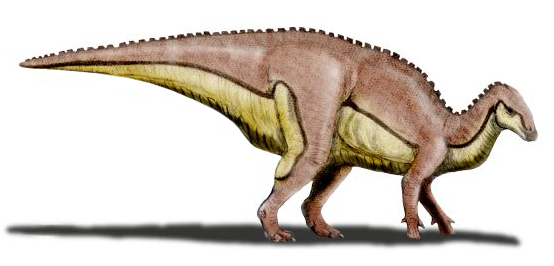|
Xuwulong NT
''Xuwulong'' is a genus of hadrosauroid dinosaur from the Early Cretaceous period. It lived during the early Cretaceous period in what is now Yujingzi Basin in the Jiuquan area, Gansu Province of northwestern China. It is known from the holotype – GSGM F00001, an articulated specimen including a complete cranium, almost complete axial skeleton, and complete left pelvic girdle from Xinminpu Group. ''Xuwulong'' was named by You Hailu, Li Daqing and Liu Weichang in 2011 and the type species is ''Xuwulong yueluni''; the binomial name as a whole refers to Professor Wang Yue-lun; "Xu-wu" is his courtesy name. Discovery and naming Expeditions into the Gansu Province of northwestern China began with the Sino-Swedish Expedition of 1930 to 1931, where discoveries of dinosaurs including the now-dubious early ceratopsian '' Microceratops sulcidens''. These discoveries were followed by occasional observations of dinosaur bones in the Houhongquan Basin in the 1960s, and then the Gongpoquan ... [...More Info...] [...Related Items...] OR: [Wikipedia] [Google] [Baidu] |
Early Cretaceous
The Early Cretaceous (geochronology, geochronological name) or the Lower Cretaceous (chronostratigraphy, chronostratigraphic name) is the earlier or lower of the two major divisions of the Cretaceous. It is usually considered to stretch from 143.1 Megaannum#SI prefix multipliers, Ma to 100.5 Ma. Geology Proposals for the exact age of the Barremian–Aptian boundary ranged from 126 to 117 Ma until recently (as of 2019), but based on drillholes in Svalbard the defining Anoxic event#Cretaceous, early Aptian Oceanic Anoxic Event 1a (OAE1a) was dated to 123.1±0.3 Ma, limiting the possible range for the boundary to c. 122–121 Ma. There is a possible link between this anoxic event and a series of Early Cretaceous large igneous provinces (LIP). The Ontong Java Plateau, Ontong Java-Manihiki Plateau, Manihiki-Hikurangi Plateau, Hikurangi large igneous province, emplaced in the South Pacific at c. 120 Ma, is by far the largest LIP in Earth's history. The Onto ... [...More Info...] [...Related Items...] OR: [Wikipedia] [Google] [Baidu] |
Sino-Swedish Expedition
The Sino-Swedish Expedition was a bilateral Chinese-Swedish expedition, led by Sven Hedin, which carried out scientific research in north and northwest China, 1927–1935. About the Expedition The Expedition looked in particular at the meteorology, topography and prehistory in Mongolia, the Gobi Desert and Xinjiang. Chiang Kai-shek was a patron of the Expedition. * 1927–32 – from Beijing – via Baotou, Mongolia, the Gobi Desert, Xinjiang – to Ürümqi * 1933–34 – from Beijing to Kashgar, with a view to constructing two roads suitable for cars Between 1927 and 1935, Hedin led an international Sino-Swedish Expedition which investigated the meteorological, topographic and prehistoric situation in Mongolia, the Gobi Desert and Xinjiang. Hedin described it as a peripatetic university in which the participating scientists worked almost independently, while he—like a local manager—negotiated with local authorities, made decisions, organized whatever was necessary, raise ... [...More Info...] [...Related Items...] OR: [Wikipedia] [Google] [Baidu] |
Carnegie Museum Of Natural History
The Carnegie Museum of Natural History (abbreviated as CMNH) is a natural history museum in the Oakland (Pittsburgh), Oakland neighborhood of Pittsburgh, Pennsylvania. It was founded by List of people from the Pittsburgh metropolitan area, Pittsburgh-based industrialist Andrew Carnegie in 1896. Housing some 22 million specimens, the museum features one of the most extensive paleontological and entomological collections in the world. Description and history The museum consists of organized into 20 galleries as well as research, library, and office space. It holds some 22 million specimens, of which about 10,000 are on view at any given time and about 1 million are cataloged in online databases. In 2008 it hosted 386,300 admissions and 63,000 school group visits. Museum education staff also actively engage in outreach by traveling to schools all around western Pennsylvania. The museum gained prominence in 1899 when its scientists unearthed the fossils of ''Diplodocus carnegi ... [...More Info...] [...Related Items...] OR: [Wikipedia] [Google] [Baidu] |
University Of Pennsylvania
The University of Pennsylvania (Penn or UPenn) is a Private university, private Ivy League research university in Philadelphia, Pennsylvania, United States. One of nine colonial colleges, it was chartered in 1755 through the efforts of founder and first president Benjamin Franklin, who had advocated for an educational institution that trained leaders in academia, commerce, and public service. The university has four undergraduate schools and 12 graduate and professional schools. Schools enrolling undergraduates include the College of Arts and Sciences, the University of Pennsylvania School of Engineering and Applied Science, School of Engineering and Applied Science, the Wharton School, and the University of Pennsylvania School of Nursing, School of Nursing. Among its graduate schools are its University of Pennsylvania Law School, law school, whose first professor, James Wilson (Founding Father), James Wilson, helped write the Constitution of the United States, U.S. Cons ... [...More Info...] [...Related Items...] OR: [Wikipedia] [Google] [Baidu] |
Mazongshan Dinosaur Fauna
The Xīnmínbǎo Group () is a group of geological formations in north central China. They occur across a large depression between the Altai Mountains of Mongolia to the north and the Qilian mountains of the Qinghai Plateau to the south, in the Gōngpóquán (公婆泉) and Suànjǐngzi (算井子) basins, and also in the neighbouring Jiuquan Basin. Both of these areas are inland basins consisting of fluvial (river), lacustrine (lake), and intermontane (between mountains) alluvial fan (floodplain) sediments that were deposited during the Early Cretaceous, probably during the Aptian or possibly late Barremian stage, when the climate was semi-arid and subtropical. The group has been visited by many expeditions including the Silk Road dinosaur expedition of 1992 which concentrated on the area around Mazong Shan. Geology The group is made up of three main formations. Chijinbao Formation This consists of a lower red unit of coarse conglomerates grading to fine sandstones re ... [...More Info...] [...Related Items...] OR: [Wikipedia] [Google] [Baidu] |
Skull
The skull, or cranium, is typically a bony enclosure around the brain of a vertebrate. In some fish, and amphibians, the skull is of cartilage. The skull is at the head end of the vertebrate. In the human, the skull comprises two prominent parts: the neurocranium and the facial skeleton, which evolved from the first pharyngeal arch. The skull forms the frontmost portion of the axial skeleton and is a product of cephalization and vesicular enlargement of the brain, with several special senses structures such as the eyes, ears, nose, tongue and, in fish, specialized tactile organs such as barbels near the mouth. The skull is composed of three types of bone: cranial bones, facial bones and ossicles, which is made up of a number of fused flat and irregular bones. The cranial bones are joined at firm fibrous junctions called sutures and contains many foramina, fossae, processes, and sinuses. In zoology, the openings in the skull are called fenestrae, the most ... [...More Info...] [...Related Items...] OR: [Wikipedia] [Google] [Baidu] |
Archaeoceratops
''Archaeoceratops'', meaning "ancient horned face", is a genus of basal neoceratopsian dinosaur from the Early Cretaceous (Aptian stage) of north central China. It appears to have been bipedal and quite small, reaching in length and in body mass. It had a comparatively large head but no horns, possessing only a small bony frill projecting from the back of its head. Discovery and species Two specimens were found in the Middle Gray Unit of the Xinminbao Group, Gongpoquan Basin of the Mazong Shan area of Gansu Province, north central China. The type species, ''A. oshimai'', was named by Dong Zhiming and Azuma in 1997. It is the first basal neoceratopsian discovered in this area. The type specimen, IVPP V11114, consists of a partially complete skeleton including skull, caudal vertebrae, pelvis, and most of a hind foot. The second specimen (paratype), IVPP V11115, consists of an incomplete skeleton with a relatively well preserved caudal series, a partial hind limb, and a co ... [...More Info...] [...Related Items...] OR: [Wikipedia] [Google] [Baidu] |
Fukui Prefectural Dinosaur Museum
The , located in Katsuyama, Fukui, Japan, is one of the leading dinosaur museums in Asia that is renowned for its exhibits of fossil specimens of dinosaurs and paleontological research. It is sited in the Nagaoyama Park ( Katsuyama Dinosaur Forest Park) near the Kitadani Dinosaur Quarry that the Lower Cretaceous Kitadani Formation of the Tetori Group is cropped out and a large number of dinosaur remains including ''Fukuiraptor kitadaniensis'' and ''Fukuisaurus tetoriensis'' are found and excavated. Since October 2009, the entire area of Katsuyama City has been recognized as a Japanese Geopark "". Since July 2014, the guide tour to the field station next to the excavation site has been available from the end of April to early November. Dozens of fossil specimens of five named dinosaurs and their excavation site have been designated as a Natural Monument of Japan since February 2017. The Asia Dinosaur Association Secretary Office has been housed inside the museum since its esta ... [...More Info...] [...Related Items...] OR: [Wikipedia] [Google] [Baidu] |
Yoichi Azuma
{{Short pages monitor ... [...More Info...] [...Related Items...] OR: [Wikipedia] [Google] [Baidu] |
Institute Of Vertebrate Paleontology And Paleoanthropology
The Institute of Vertebrate Paleontology and Paleoanthropology (IVPP; ) of People's Republic of China, China is a research institution and collections repository for fossils, including many dinosaur and pterosaur specimens (many from the Yixian Formation). As its name suggests, research is focused on both paleontology, paleontological topics and those relating to human prehistory. The institution, located in Beijing, grew out of the Cenozoic Research Laboratory in 1929 and is its own institution under the Chinese Academy of Sciences. Its staff have increasingly worked internationally, participating in the China-Canada Dinosaur Project from 1986 to 1991 and authoring or coauthoring forty-five ''Nature (journal), Nature'' and ''Science (journal), Science'' articles from 1999 to 2005. Notable paleontologists who have been affiliated with the IVPP include Yang Zhongjian (also known as C. C. Young), Dong Zhiming, Meemann Chang and Zhao Xijin. See also * List of museums in China Re ... [...More Info...] [...Related Items...] OR: [Wikipedia] [Google] [Baidu] |
Dong Zhiming
Dong Zhiming (Chinese language, Chinese: 董枝明, Pinyin: ''Dǒng Zhimíng''; January 1937 – 20 October 2024) was a Chinese vertebrate paleontologist formerly employed at the Institute of Vertebrate Paleontology and Paleoanthropology (IVPP) in Beijing. He began working at the IVPP in 1962, studying under Yang Zhongjian, who was director at the time. He described fossil remains of many dinosaurs. He investigated and described the Shaximiao Formation; an important contribution to science since they are composed of Middle Jurassic beds which do not commonly yield fossils. Early life and education Dong Zhiming was born in January 1937 in Weihai, Shandong. At the age of 13, Dong was introduced to dinosaurs by a museum exhibit showcasing hadrosaur fossils. Dong graduated from university in 1962 with a degree in biology. Career After graduating, Dong Zhiming began working at the Institute of Vertebrate Paleontology and Paleoanthropology (IVPP) in Beijing where he was mentored by Y ... [...More Info...] [...Related Items...] OR: [Wikipedia] [Google] [Baidu] |
Sino-Japanese Silk Road Dinosaur Expedition
Sino-Japanese is often used to mean: * Sino-Japanese vocabulary: That portion of the Japanese vocabulary that is of Chinese origin or makes use of morphemes of Chinese origin (similar to the use of Latin/Greek in English). * Kanbun: A Japanese method of reading annotated Classical Chinese in translation; writing with literary Chinese for Japanese readers. * The ''on'yomi'' or 'Chinese reading' of Chinese characters in Japanese. "Sino-Japanese" is also used to refer to that which occurs between China and Japan, such as: * The First Sino-Japanese War between 1894 and 1895, primarily over control of Korea. * The Second Sino-Japanese War between 1937 (some say the true start date is 1931) and 1945, from 1941 on as part of World War II * Sino-Japanese relations * Sino-Japanese Journalist Exchange Agreement * Chinese people in Japan * Japanese Chinese cuisine, the style of Chinese cuisine served by Chinese in Japan * Japanese people settled in China, and/or their descendants * Japanese ... [...More Info...] [...Related Items...] OR: [Wikipedia] [Google] [Baidu] |









